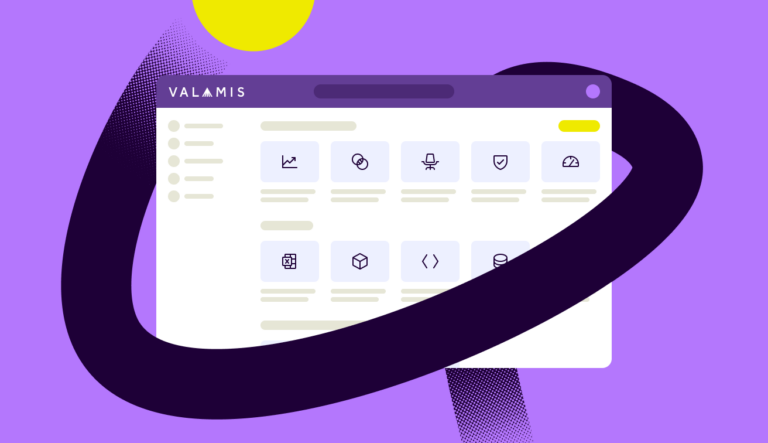Gamification
Learn what gamification is and discover its examples in workforce development. How to develop an effective gamification effort for employee training.

After reading this guide, you will understand the best ways to establish gamification in learning. And will be able to improve training and development programs within your organization.
You will learn how gamification can improve training outcomes, employee engagement, and customer satisfaction.
Discover:
- What is gamification?
- How gamification can help your organization
- Gamification in corporate training
- Gamification in the workplace
- Virtual Reality (VR) training gamification
- Gamification examples
- How to implement gamification in your organization
What is gamification?
Gamification is the process of using game mechanics, elements, and principles and applying them to non-game contexts to engage users better.
Gamification can be used in many different contexts. Businesses often apply gamification to employee training, recruitment, evaluation, and organizational productivity.
Other uses include physical activity, voter engagement, and customer loyalty programs.
The point of gamification is to inspire users to engage with the content. Especially with tasks that are not enjoyable, such as an in-depth safety training program or compliance training.
Some examples of game mechanics used in gamification are:
- Goals – Complete the task and get a reward, such as a badge or points.
- Status – Users increase their level or rank through completing activities. Leaderboards show who is ‘winning’ and inspire users to work harder to compete.
- Community – Users are paired or put in groups to solve problems, complete activities, or otherwise achieve an objective.
- Education – Tips, tricks and quizzes are given to the user throughout the process.
- Rewards – As mentioned above, points and badges are common, and useful, rewards. Other rewards could be discounts, coupons, or gift cards. This fuels the user’s motivation and keeps engagement high.
Successful gamification will tap into the user’s intrinsic motivation, such as becoming more skilled at their job, while offering an extrinsic motivation, such as rewards, points and badges.
How gamification can help your organization
When your organization implements gamification, you will gain more than just increased engagement from users.
Gamification helps organizations achieve direct and indirect business objectives by linking the games to clear business goals.
Gamification can help your organization to:
- Establishing a learning culture
- Find and fix knowledge gaps
- Energize boring training programs
- Streamline training processes
- Create effective employee onboarding processes
- Keep employees up to date on company policies, products and software
- Make learning about products fun and effective
- Establish and spread positive employer branding
- Connect with employees and promote team building
- Train staff on new technology
- Update and improve compliance policies

The definitive guide to microlearning
The what, why, and how-to guide to inject microlearning into your company.
DOWNLOAD GUIDEHow gamification can help in corporate training
There are three main areas in which it can help improve corporate training.
1. Onboard new employees
Successfully onboarding new employees is always a challenge, and overdependence on dry, boring onboarding documents, videos and training sessions means that organizations lose the opportunity to engage employees from day one. By using gamification in training, an organization will avoid these issues.
2. Improve training results
By using gamification during the training process, an organization creates a win-win situation in which the employee is engaged, learning is made more fun, and the employee is much more likely to remember the information they are being taught.
Using interactive methods based on real-life work scenarios, organizations can help new employees better understand the demands of their role, the expectations for behavior, and organizational standards.
3. Make boring or routine training an engaging experience
Every organization has certain safety, compliance, or legal procedures that employees must learn or periodically review.
These routine training procedures are often dry, unengaging, or just plain boring.
When a company uses gamification to turn this training into an engaging experience, they gain safer employees who are much less likely to forget this important information.
Gamification in the workplace
Many organizations are turning to gamification to improve employee engagement, productivity and reduce turnover in the workplace.
Gamification for training
Can be used in existing or new training programs to:
- Onboard new employees
- Retrain current employees
- Teach employees about new products
- Improve staff understanding of company policies
- Increase compliance
- Teach staff about new software or technology
- Help employees upskill
Gamification in team building
Can be used to help with team building:
- Introduce and get to know new team members
- Build trust within the team
- Improve teamwork
- Encourage collaboration
- Improve morale and motivation
- Broaden communication skills
Gamification to improve results
Tap into your staff’s natural competitiveness to:
- Create competitions for sales, product knowledge or leads
- Establish leaderboards within teams, departments, branches or across the whole company
- Promote information sharing across teams
- Improve employee engagement
- Incentivize delivering great service to customers
Virtual Reality (VR) training gamification
Virtual reality is the new frontier in gamification in training.
Every year, more companies are exploring VR and what it can bring to their training programs.
Virtual reality training is extremely effective as a tool. The ability to fully immerse into the training scenario and experience it completely leads to increased engagement with the material, improved understanding of the concepts, and better retention of information. The industries adopting VR training are widely varied, showing the potential of this technology to fit into many scenarios.
Virtual reality can be brought in to replace training scenarios where it is too expensive, dangerous, time-consuming, or unrealistic to do in real life. For pilots, firefighters, rescuers, military and law enforcement, virtual reality can help them learn how to respond in high-intensity scenarios that would otherwise not be available for them to safely engage with.
Not only is VR useful in these scenarios, organizations across many industries have found success in using VR in their training programs.
- Rail companies use VR to train personnel from conductors to drivers to engineers.
- Manufacturers use VR to safely train staff on new equipment, preventing errors, casualties or equipment damage. Safety and compliance training can be made into an engaging and memorable experience through virtual reality.
- Other companies have used virtual reality to enhance their code of conduct training, putting employees into situations that test their morals or decision-making skills.
Virtual reality can even improve communication, trust and empathy within the workplace. This can be particularly helpful with geographically separated teams, as creating a VR meetingplace can encourage cohesion. Implementing training with VR can help turn abstract ideas into concrete, understandable personal experience.
Using virtual reality in a gamification context in corporate training has two drawbacks.
First, it is not cheap. While it can be cheaper than some types of on-the-ground training, it is still an expensive technology to utilize.
Secondly, although the VR industry is fast-growing, there are not many companies who can produce VR training programs.

The definitive guide to microlearning
The what, why, and how-to guide to inject microlearning into your company.
DOWNLOAD GUIDEGamification examples
From training to day-to-day operations, these examples will show you how your organization can integrate gamification.
Real-life successful gamification examples
1. Cyber Discovery
Cyber Discovery is a learning program launched in 2017 as a four-year program, funded and supported by the Department for Digital, Culture, Media and Sport (DCMS) as part of the UK’s National Cyber Security Strategy.
It was created by SANS Institute as a free extracurricular program for 13 to 18 year-olds across the UK.
Eventually, they launched the online cyberlearning platform CyberStart.
Watch the following video on how cybersecurity experts applied gamification to engage learners during this program.
2. Siemens
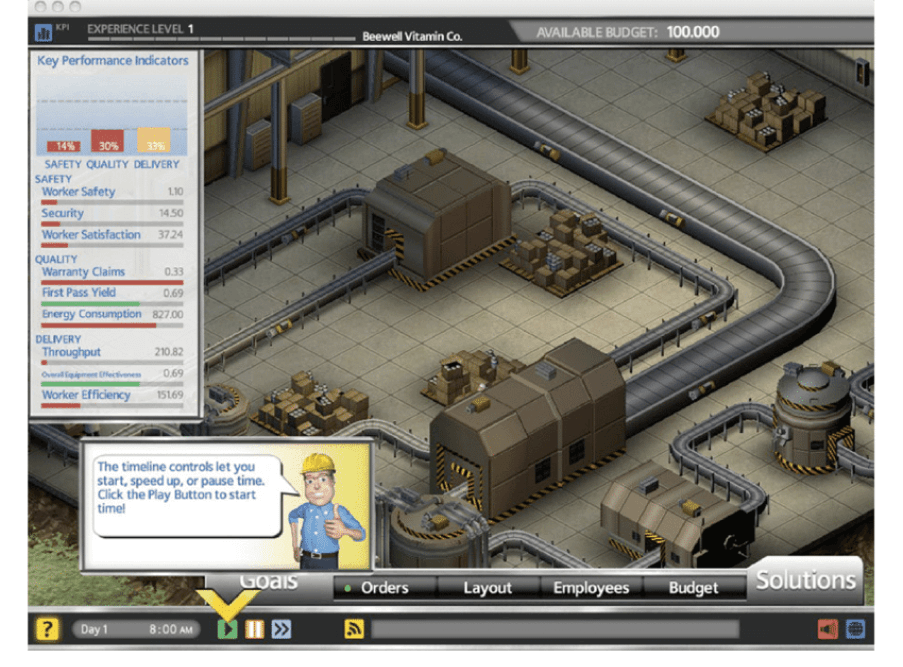
The Plantville game used by Siemens
Siemens successfully used storytelling to teach plant managers how to better operate their plants with a game, Plantville, that gave valuable training and development information.
Players, in the role of the plant manager, had to solve problems, run the plant, and perform other key tasks.
Feedback was instant, points were awarded for making good decisions within the game, and managers were engaged.
3. Salesforce
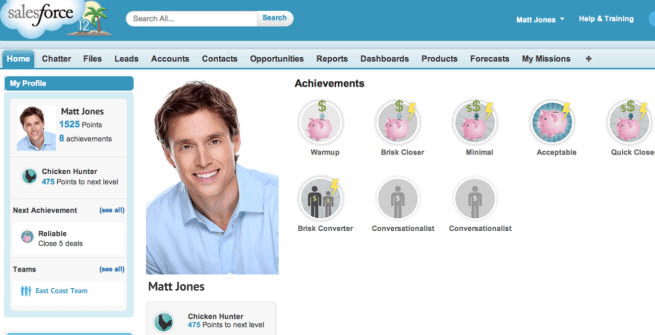
A program called Big Game Hunter
Salesforce used a hunting game to engage users to interact with more aspects of the platform, taking users from a ‘chicken hunter’ all the way up to a ‘big game hunter’ as they interacted.
Compliance rates increased, in one case up to 40% more than previously.
4. Cisco
Cisco engaged their staff to become social media masters through gamification.
They had a massive training program of over 46 courses, leaving users confused and overwhelmed.
By applying a learning path, split into three levels of certification and accessing points and badges along the way, as well as team challenges, they simplified the process and engaged users.
5. Microsoft
Microsoft successfully used a simple game and leaderboards to help keep the language on their programs error-free.
They produced a game where staff would check the accuracy of language within their programs.
They also introduced intentionally poor translations, to keep players engaged.
By introducing a leaderboard between offices around the world, staff were properly engaged with the game and the effect was extremely effective.
6. Duolingo
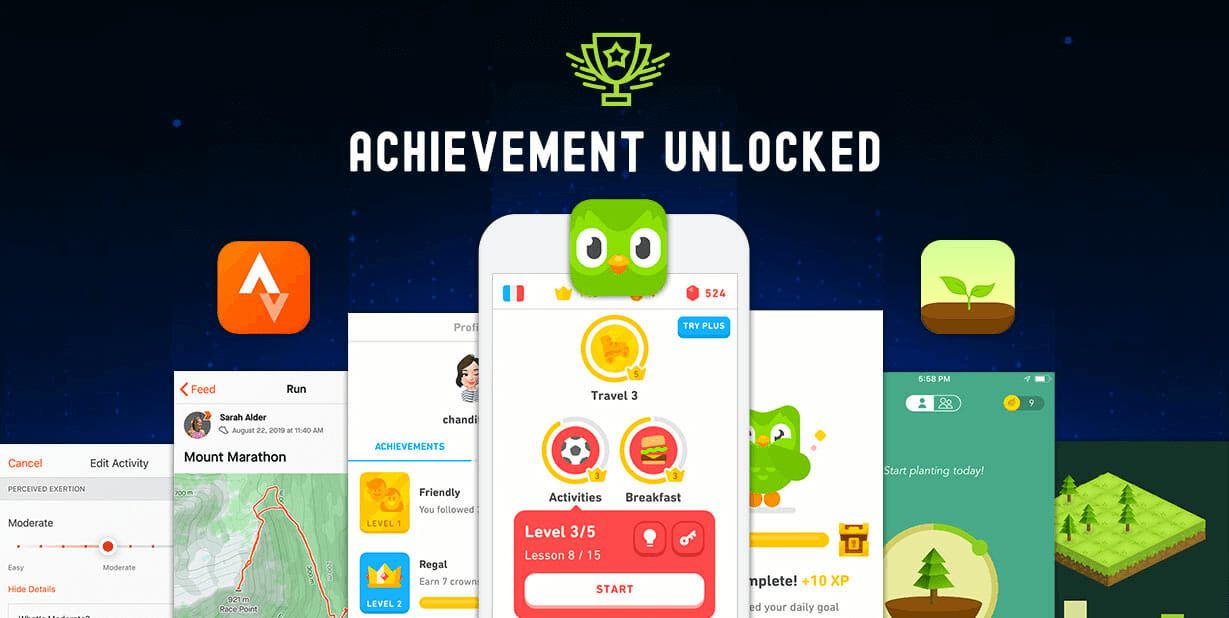
The Duolingo app
Duolingo is the best-known example of using gamification to make learning fun and engaging.
Language learning can be a slog and takes a long time to see results.
Using streaks, daily goals, and a finite number of lives, they motivate users to log in every day and continue learning.
7. Yousician

The music learning app Yousician
Another education app that motivates students to engage, Yousician helps users learn to play an instrument using an incentivized learning path that increases in difficulty as they go along.
The key function of this app is the instantaneous feedback that users get, helping then improve in realtime.
8. Nike+ Run Club
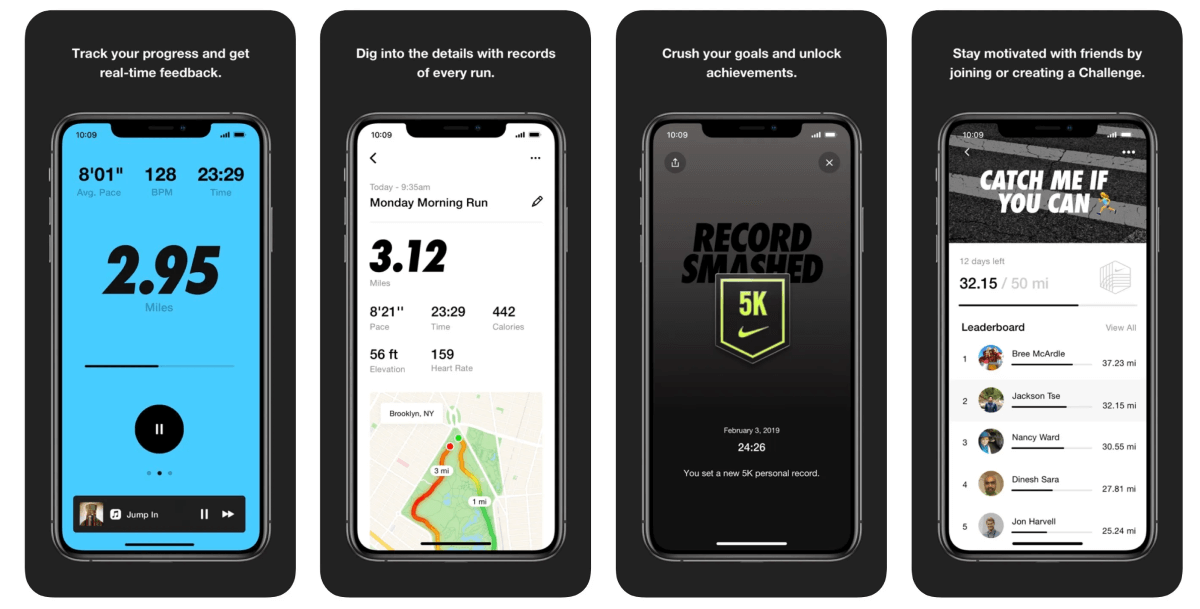
Nike Running app
Nike, a leader in all things fitness, developed this app to help motivate and engage users in their fitness journeys.
Using leaderboards, challenges, badges, and trophies, Nike+ lets users compete against athletes around the world.
Tapping into the competitive urges of users, as well as providing training plans, fitness tips, and the ability to track personal improvements, Nike engages their users on all levels.
9. ChoreWars
This simple program helps turn mundane tasks into an engaging adventure.
Ordinary tasks are turned into steps that must be completed for the characters to continue their journey, users are rewarded for completing their duties, and a healthy bit of competition can be introduced through leaderboards.
10. Simple Energy
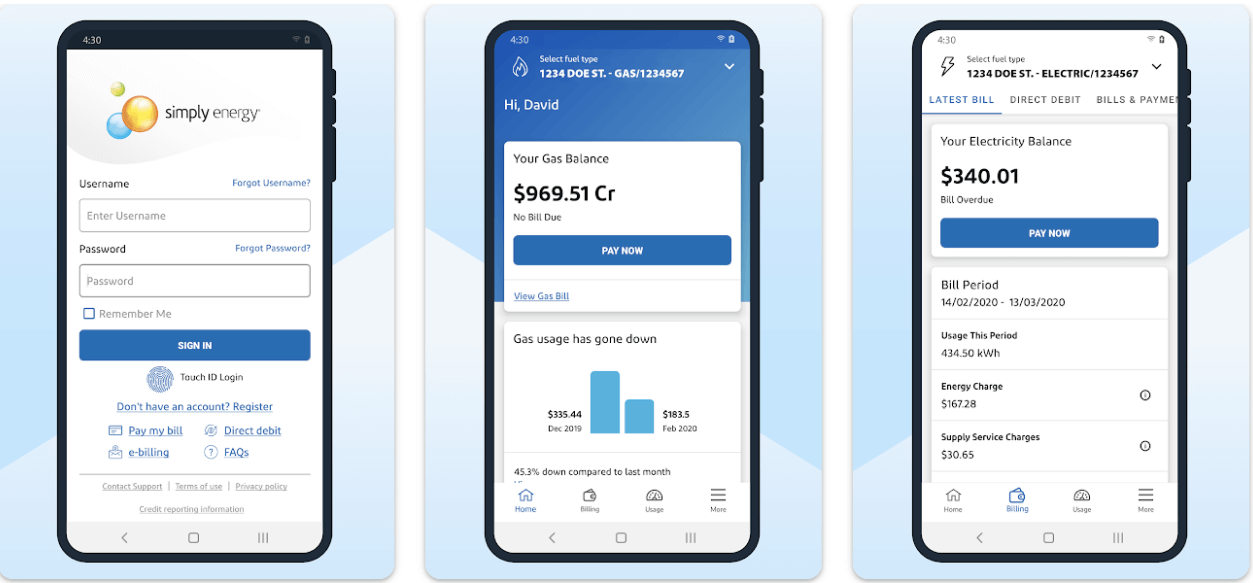
Simple Energy app
Simple Energy wanted to inspire users to reduce energy consumption, and so they developed an app to help inform, engage and motivate people towards that goal.
By giving relevant information, deploying a leaderboard of super-savers and creative competitions, users reduce their energy consumption while having fun.
11. Swedish speed camera lottery

The speed camera lottery in Stockholm, Sweden
In trying to reduce incidences of speeding, the Swedish capital Stockholm debuted a lottery that gave prizes to those caught obeying the traffic laws.
Speed cameras were already in use to catch speeders, but were now doing two jobs – catching speeders and catching those who were obeying the speed laws.
The people obeying speed laws were entered into a lottery, with the cash prize being taken from the fines that speeders paid.
It was a massive success, lowering average speeds on Stockholm’s roads from 32 to 25 km per hour.
How to implement gamification in your organization
This task requires an understanding of the psychology of motivation, as well as a solid plan of what the end results should be.
1. Inserting gamification into existing training programs
Your organization doesn’t have to start from scratch to integrate gamification.
Game mechanics can be inserted into the existing training process.
At the points in which your current training involves solving problems, looking at real-world examples of challenges and changing behaviors, quizzes can be used, with a point-based leaderboard or badges rewarding high scores.
2. Motivating through rewards
Awarding employees points for completing tasks, badges for upskilling, or recognition for successfully completing a training path can keep them engaged with the training program.
Using a point system, employees can earn various real-world rewards, like an extra day off or a gift card.
Badges are not useless items, according to IBM Digital Badge Pilot run in 2015, they saw significant results in learners engagement metrics.
“Student enrollments increased by 129% and the percentage of enrollees who actually completed courses increased by 226%. The number of students passing the end-of-course exam increased by 694% compared to the six-week period leading up to the introduction of digital badges.”

Another approach shows that badges can foster a learning culture inside an organization, especially if it’s a physical badge.
The Russian railway grants physical badges to students who graduate from their online corporate university. Similar to the martial arts belt system, the Russian railway implemented different colored badges that signify different levels of seniority, immediately available upon completion of degrees so people could receive recognition right away. They noticed that employees started wearing them at work and especially at official meetings.
Eventually, the university received multiple requests from the previous years’ students, who had finished before the new badge system was implemented, about getting their own badges.
As you can see, badges are not always about leaderboards and competition, it can be part of recognition and belonging.
Source Yandex Music Podcast “Не до разговоров #19”: Roman Baskin, Director of the Corporate University of Russian Railways.
3. Use storytelling to engage
Developing a game that follows the daily operations and tasks of a specific role using dynamic storytelling can keep employees engaged with the activity.
Have employees play through the role, solving problems, making judgment calls and assessing solutions.
The results will show you where their strengths and weaknesses are, as well as showing employees how they can better perform in their role.
4. Tap into competition to boost engagement
Most people are at least somewhat competitive. By setting goals, having point systems, or company-wide leaderboards, you can tap into that side of your employees nature.
To work optimally, gamification must be developed and implemented properly. Poorly designed gamification apps or programs will have the opposite effect on employees, disengaging them from the desired results.
- Cleary and concretely identify what they want to achieve through gamification.
- Create a list of how those goals can be reached through changed behavior or skills.
- Develop the app or system, keeping in mind that the user experience will be the most important factor.
- Ensure that users understand the end goals and purpose of the app or system.
Using the natural desire to compete, organizations can turn process of acquiring new knowledge into a game, using quizzes, points and a leaderboard system to inspire employees to master new knowledge.
5. Set out a learning path
People like to know the path to success, gamification gives them a clear view of what they must do to succeed.
When bringing in new technology, product or software, it can be a challenge to make sure that employees are engaging with it fully.
A successful gamification example would be developing a path that pairs challenges and quizzes with a point system and leaderboard. Employees develop their knowledge through this system, competing against their peers as to who can master the software fully.
Summary
All of these ideas of how to implement gamification in the workplace tap into the human desire to follow a clear path, get rewarded for activities, and engage the competitive spirit.
The best gamification examples don’t necessarily have the most bells and whistles, although you could integrate cutting edge technology, like 3D virtual environments. Rather, they are tailored to the environment, the user, and the end goals of the organization.
Negative effects of bad implementation
There are some cases where gamification, when not thought through and integrated properly, will actively disengage employees.
Omnicare, an American healthcare and pharmacy provider, attempted to gamify their system to increase efficiency.
The plan was to reduce the time each customer interaction took by timing help desk staff while using points and a leaderboard to show who was winning and putting a reward system in place.
The effect was an increase in both wait times and employee turnover. Employees felt as though they were being monitored entirely too much, that feedback was not helpful, and that they were being rushed to provide subpar care.
The system was eventually fixed by focusing on achievements, rather than wait times.
When developing a gamification system, the organization has to think carefully about the desired outcome, implement a well-designed system to help employees reach the goals set out for them, and be responsive to employee feedback.

The definitive guide to microlearning
The what, why, and how-to guide to inject microlearning into your company.
DOWNLOAD GUIDE

